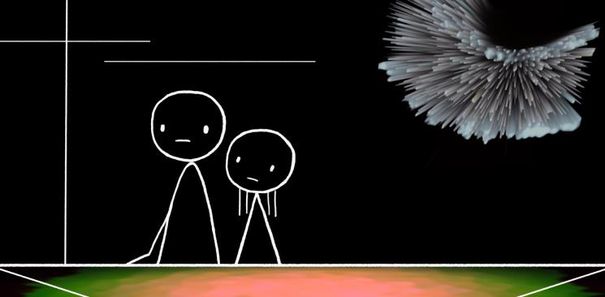A Call from the Future
by Lilla Puskás

A little girl receives a phone call from the distant future. The woman, whose voice lacks the slightest emotion, talks very formally, almost like a robot, turns out to be her grand daughter who wants to say something important to her acestor. In World of Tomorrow (2015), the US-based indie animator, Don Hertzfeldt tells a science fiction story, using many humorous elements both in narration and visual depiciton.
The future grandchild insists on sharing her memories with her, she invites Emily to take a peek into her world where technology dominates over human feelings. As here people are all clones, a romantic relationship is not necessary for reproduction any more. Women rather fall in love with rocks or fuel pumps than men and talk about their feelings as mental and emotional shortcomings. Their job is programming robots, when they get tired, they go on holiday to Mars.
Despite the advance state of technology, society doesn't differ a bit from today's: there are huge differences between rich and poor, first of all, in their access to technological inventions. As long as wealthy citizens can enjoy several advantages of technology, the poor can't afford those; unlike their rich collegues, they live a painful life or die unnoticed. The movie's satirical tone leads to a black comedy, in which the main source of humour is the lack of empathy. It is not only about creating an upside down image about the future of humanity, but also the absurdity of sharing heavy information with a five year old child, who is not able to understand it yet, and not surprisingly, doesn't care too much either.
There's an interesting contrast between plot and visuals. Plot-wise, the most significant problems in science, such as time-travelling or medical experiments on human bodies, seem to be ridiculously simple, only human beings see them as difficult. In contrast to the plot, in terms of visuals human characters appear very simple as images drawn by one line, while the backround images representing the world of science, consist of many colorful, geometric elements which makes them seem very complex. Besides this, different ages appear in different visual styles: the far future in vivid neon colours with sharp outlines, while the past appears brown and a bit blurred.
Sarcasm, creativity and playfulness make together a smart and memorable piece. Whilst 17 minutes seem longer than necessary, and the too many details on life in the future gives the impression of repetition, slow information dosing gives a special rhythm to the movie and helps the viewer to maintain his attention. Don Hertzfeldt's ingenious piece has been awarded 14 prizes so far, among them the Audience Award and the Special Distinction in Annecy, and the Short Film Grand Jury Prize at Sundance Film Festival.

